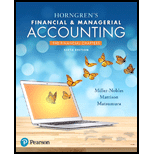
1.
Long-Term Notes Payable
Long-term notes payable refers to the obligation of the company in the form of notes to be paid after one year or one operating cycle whichever is longer. Generally the long-term notes payable is reported in the long-term liabilities section of the balance sheet.
Rules of debit and credit:
“An increase in an asset account, an increase in an expense account, a decrease in liability account, and a decrease in a revenue account should be debited.
Similarly, an increase in liability account, an increase in a revenue account and a decrease in an asset account, a decrease in an expenses account should be credited”.
To Journalize: The issuance of the note on January 1, 2018.
2.
To Journalize: First note payment on December 31, 2018.
Want to see the full answer?
Check out a sample textbook solution
Chapter 12 Solutions
Horngren's Financial & Managerial Accounting, The Financial Chapters (6th Edition)
- I am searching for the correct answer to this financial accounting problem with proper accounting rules.arrow_forwardPlease provide the answer to this financial accounting question with proper steps.arrow_forwardCan you explain the correct approach to solve this general accounting question?arrow_forward
- The standard materials cost to produce 1 unit of Product S is 5 pounds of material at a standard price of $35 per pound. In manufacturing 9,500 units, 46,800 pounds of material were used at a cost of $36 per pound. What is the total direct materials cost variance?arrow_forwardDefine and differentiate between capital expenditure and revenue expenditure. Why is it important for businesses to classify these correctly in financial statements? Support your explanation with at least one example for each type of expenditure.arrow_forwardwhat would have been the amount of acual overhead ?arrow_forward
- I need assistance with this financial accounting question using appropriate principles.arrow_forwardSolve with explanation and accounting questionarrow_forwardWhen preparing the trial balance, the accountant of Zenith Co. noticed that the debit column exceeded the credit column by $1,000. Which of the following errors could cause such an imbalance? A) A transaction not recorded at all B) Reversing the debit and credit C) Posting an amount twice to the debit side D) Recording a sale as a purchase MCQarrow_forward

 AccountingAccountingISBN:9781337272094Author:WARREN, Carl S., Reeve, James M., Duchac, Jonathan E.Publisher:Cengage Learning,
AccountingAccountingISBN:9781337272094Author:WARREN, Carl S., Reeve, James M., Duchac, Jonathan E.Publisher:Cengage Learning, Accounting Information SystemsAccountingISBN:9781337619202Author:Hall, James A.Publisher:Cengage Learning,
Accounting Information SystemsAccountingISBN:9781337619202Author:Hall, James A.Publisher:Cengage Learning, Horngren's Cost Accounting: A Managerial Emphasis...AccountingISBN:9780134475585Author:Srikant M. Datar, Madhav V. RajanPublisher:PEARSON
Horngren's Cost Accounting: A Managerial Emphasis...AccountingISBN:9780134475585Author:Srikant M. Datar, Madhav V. RajanPublisher:PEARSON Intermediate AccountingAccountingISBN:9781259722660Author:J. David Spiceland, Mark W. Nelson, Wayne M ThomasPublisher:McGraw-Hill Education
Intermediate AccountingAccountingISBN:9781259722660Author:J. David Spiceland, Mark W. Nelson, Wayne M ThomasPublisher:McGraw-Hill Education Financial and Managerial AccountingAccountingISBN:9781259726705Author:John J Wild, Ken W. Shaw, Barbara Chiappetta Fundamental Accounting PrinciplesPublisher:McGraw-Hill Education
Financial and Managerial AccountingAccountingISBN:9781259726705Author:John J Wild, Ken W. Shaw, Barbara Chiappetta Fundamental Accounting PrinciplesPublisher:McGraw-Hill Education





